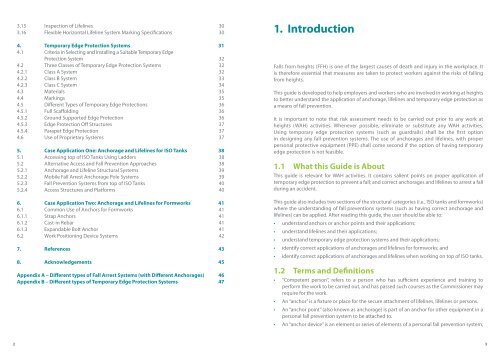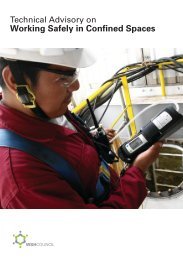HERE - Workplace Safety and Health Council
HERE - Workplace Safety and Health Council
HERE - Workplace Safety and Health Council
Create successful ePaper yourself
Turn your PDF publications into a flip-book with our unique Google optimized e-Paper software.
3.15 Inspection of Lifelines 303.16 Flexible Horizontal Lifeline System Marking Specifications 304. Temporary Edge Protection Systems 314.1 Criteria in Selecting <strong>and</strong> Installing a Suitable Temporary EdgeProtection System 324.2 Three Classes of Temporary Edge Protection Systems 324.2.1 Class A System 324.2.2 Class B System 334.2.3 Class C System 344.3 Materials 354.4 Markings 354.5 Different Types of Temporary Edge Protections 364.5.1 Full Scaffolding 364.5.2 Ground Supported Edge Protection 364.5.3 Edge Protection Off Structures 374.5.4 Parapet Edge Protection 374.6 Use of Proprietary Systems 375. Case Application One: Anchorage <strong>and</strong> Lifelines for ISO Tanks 385.1 Accessing top of ISO Tanks Using Ladders 385.2 Alternative Access <strong>and</strong> Fall Prevention Approaches 385.2.1 Anchorage <strong>and</strong> Lifeline Structural Systems 395.2.2 Mobile Fall Arrest Anchorage Pole Systems 395.2.3 Fall Prevention Systems from top of ISO Tanks 405.2.4 Access Structures <strong>and</strong> Platforms 406. Case Application Two: Anchorage <strong>and</strong> Lifelines for Formworks 416.1 Common Use of Anchors for Formworks 416.1.1 Strap Anchors 416.1.2 Cast-in Rebar 416.1.3 Exp<strong>and</strong>able Bolt Anchor 416.2 Work Positioning Device Systems 427. References 438. Acknowledgements 45Appendix A – Different types of Fall Arrest Systems (with Different Anchorages) 46Appendix B – Different types of Temporary Edge Protection Systems 471. IntroductionFalls from heights (FFH) is one of the largest causes of death <strong>and</strong> injury in the workplace. Itis therefore essential that measures are taken to protect workers against the risks of fallingfrom heights.This guide is developed to help employers <strong>and</strong> workers who are involved in working at heightsto better underst<strong>and</strong> the application of anchorage, lifelines <strong>and</strong> temporary edge protection asa means of fall prevention.It is important to note that risk assessment needs to be carried out prior to any work atheights (WAH) activities. Whenever possible, eliminate or substitute any WAH activities.Using temporary edge protection systems (such as guardrails) shall be the first optionin designing any fall prevention systems. The use of anchorages <strong>and</strong> lifelines, with properpersonal protective equipment (PPE) shall come second if the option of having temporaryedge protection is not feasible.1.1 What this Guide is AboutThis guide is relevant for WAH activities. It contains salient points on proper application oftemporary edge protection to prevent a fall; <strong>and</strong> correct anchorages <strong>and</strong> lifelines to arrest a fallduring an accident.This guide also includes two sections of the structural categories (i.e., ISO tanks <strong>and</strong> formworks)where the underst<strong>and</strong>ing of fall preventions systems (such as having correct anchorage <strong>and</strong>lifelines) can be applied. After reading this guide, the user should be able to:• underst<strong>and</strong> anchors or anchor points <strong>and</strong> their applications;• underst<strong>and</strong> lifelines <strong>and</strong> their applications;• underst<strong>and</strong> temporary edge protection systems <strong>and</strong> their applications;• identify correct applications of anchorages <strong>and</strong> lifelines for formworks; <strong>and</strong>• identify correct applications of anchorages <strong>and</strong> lifelines when working on top of ISO tanks.1.2 Terms <strong>and</strong> Definitions• “Competent person”, refers to a person who has sufficient experience <strong>and</strong> training toperform the work to be carried out, <strong>and</strong> has passed such courses as the Commissioner mayrequire for the work.• An “anchor” is a fixture or place for the secure attachment of lifelines, lifelines or persons.• An “anchor point” (also known as anchorage) is part of an anchor for other equipment in apersonal fall prevention system to be attached to.• An “anchor device” is an element or series of elements of a personal fall prevention system,2 3
















